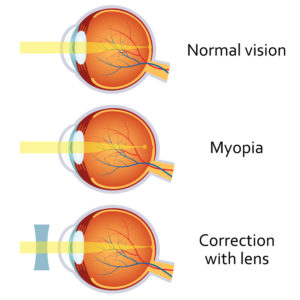Myopia | Near sighted not Near sightless
December 18, 2017
 Myopic eyes focus in FRONT of the retina. Correction allows focus ON the retina.
Myopic eyes focus in FRONT of the retina. Correction allows focus ON the retina.
Many patients who choose to have a vision correction procedure such as LASIK have myopia. Myopic patients are ABLE to see near (close distances), hence they are nearsighted (not nearsightless).
Nearsighted individuals can NOT see far away (distance) very well. The images focus in front of the retina.
Nearsighted patients have a natural near focal point; however, where near vision (e.g. reading a book) is clear and focused without glasses on the retina.
Without glasses, myopic patients can not see well at distance, hence the need for contact lenses, glasses or LASIK!
Vision correction procedures focus the light rays, when looking at objects in the distance, on the retina instead of in front of the retina.
Cornea too Steep
There are two parts of the eye responsible for focusing light. The cornea is responsible for most of the focusing power of the eye, whereas the lens makes up the balance.
More specifically, the curvature of the cornea has tremendous influence on the eye's ability to focus light.
Changing the curvature of the cornea can result in dramatic changes in the refractive power of the eye. For instance, LASIK reduces, or flattens, the curvature of the cornea in patients who are nearsighted. LASIK (and other procedures) essentially make patients less nearsighted, allowing the natural focal point to become far away, instead of just a couple of inches in front of the nose.
Reshaping the Cornea
All vision correction procedures which involve the cornea, such as LASIK, RK, PRK, etc. change the shape of the cornea. The method by which these procedures achieve the change differs, but the end goal is the same.
LASIK surgery involves reshaping of the cornea by directly reshaping the "stroma" of the cornea with a laser after the superficial corneal flap is created.
Once the underlying cornea is reshaped, the corneal flap is repositioned. The amount of reshaping depends upon each patient's specific refraction and visual needs.
The precision of the laser allows surgeons, like Dr. Whitten, to precisely and accurately reshape the curvature of the cornea to give our patients very predictable results.
If you are interested in making an appointment with Dr. Rose or Dr. Whitten at any of our locations, please call or email us!



